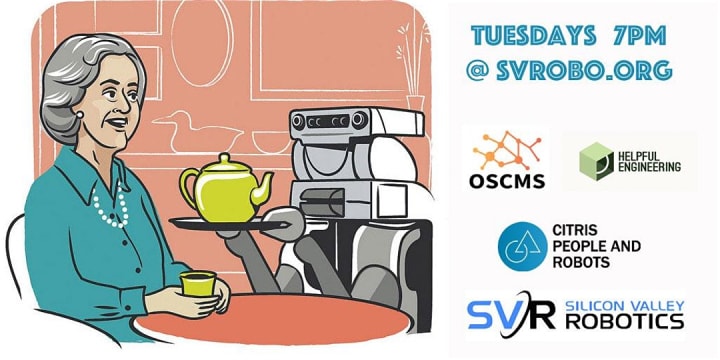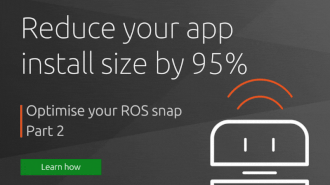Rhys Davies
on 3 April 2020
Damn it March. 2020 was doing so well. The biggest news last month was the dramatic escalation of COVID-19. We won’t go into any detail, I’m sure you’re seeing enough of that. But due to the outbreak, the state of robotics this March has been, heartwarming. We have seen a surge in online learning platforms, companies, startups and communities rising to the challenge. Members of open-source communities across the world are doing great things, with and without robotics, to support whoever they can. In this blog, we first want to highlight at a few responses to COVID-19 using robotics. And then it’s back to usual programming, highlighting robotics work and projects we have seen or done in March. If we have missed something in particular, please reach out to robotics.community@canonical.com and let us know.
COVID-19, robots and us – A Discussion
Let’s start with awareness. Silicon Valley Robotics and the CITRIS People and Robots Initiative are hosting a weekly “COVID-19, robots and us” online discussion with experts from the robotics and health community on Tuesdays at 7pm (California time – PDT) and you can sign-up for the free event here. Each week they host different expert special guests to talk about the problem and the possible solutions.
The two communities they are promoting are Open Source COVID-19 Medical Supplies Group, a rapidly growing Facebook group formed to evaluate, design, validate, and source the fabrication of open-source emergency medical supplies. And Helpful Engineering, another rapidly growing global network created to design, source and execute projects that can help people suffering from the COVID-19 crisis worldwide. I heavily encourage you to take a look and if you are able, get involved.

Fighting SARS-CoV-2 with light and robots
In 2011, the terrible Fukushima meltdown cast a shadow of disillusion over the state of robotics for the public, and, importantly over roboticists themselves. The technology simply wasn’t up to the (incredibly) difficult tasks we wished robots could tackle for us. In 2020, as the world is facing a global pandemic, robots are assisting in all kinds of tasks. They are handling room service in isolation centres, patrolling streets and entertaining the elderly. Robots are once again under the spotlight. Some robots, *are* spotlights; UV spotlights. UVD Robots, a company founded in 2016 by BlueOcean Robotics, produces a mobile-base robot mounted with powerful UV lights. Its task is clear, kill 99.99% of pathogens where it operates. Needless to say that this help is more than welcome in hospitals currently.
UBTECH Robots in hospitals
UBTECH is an AI and humanoid robotics company that works on robots from industrial service robots to STEM educational build kits. Recently, the Third People’s Hospital of Shenzhen (TPHS), the only hospital treating COVID-19 in Shenzen despite its population of more than 12.5 million people, have enlisted the help of UBTECH robots. UBTECH have sent in three types, ATRIS, AIMBOT and Cruzr to monitor body temp, detect people without masks and spray disinfectant, respectively. We’re not sure whether they use ROS or Ubuntu, but its another case of robots rising to the occasion.
GitHub Actions for ROS 2
In non-COVID news, the ROS 2 Tooling Working group put out a set of GitHub Actions for setting up ROS on a runner and automatically building and testing packages. Setting up a CI is easier than ever, and Ubuntu Robotics’ own Ted Kern put together a primer on how to get your pipeline set up quickly and easily.

A new opportunity to learn ROS
Last month The Construct took the opportunity to broadcast a week-long series of free classes for learning how to program with ROS. The five classes are targeted at beginners with no knowledge of ROS, Linux or python, as all these are covered in the series. Each class is two hours long and the recorded videos are available on YouTube. We read about it originally in the ROS discourse, for more information head there.

ROS on a Container
Is it possible to develop ROS applications in a container? Absolutely! There are a number of reasons such as testing different releases of ROS, or to develop on multiple isolated projects. Ted Kern, a member of Canonical’s robotics team, explains how to set up a ROS development environment in LXD in this blog post. The post covers setting up a workspace, mapping your robot devices into the container, and enabling a graphical development environment.

SpotMicroAI
On another cheery note, we stumbled across an open-source project this month called SpotMicroAI. A GitLab project that teaches you how to build a miniature version of Boston Dynamics’ robotic dog product. The one Adam Savage is testing on YouTube. It’s a long term kind of project and looks quite complicated at a glance but if you can get one running to take for walks I’ll be mighty jealous. If we find some time maybe we’ll get one cracking on Ubuntu Core.

Outro
At Canonical we are privileged to have a well-established pattern of remote work and have been glad to help others by sharing our experience of distributed collaboration and operations. Our official commercial stance is please lean on us, we stand ready to help. And for the community, for projects and initiatives we can lend our help to, the same message applies. So if you have a project for us to talk about or you know of a project we missed in this article, get in touch through robotics.canonical@canonical.com and I’ll get it to the right people. Stay safe in April.



